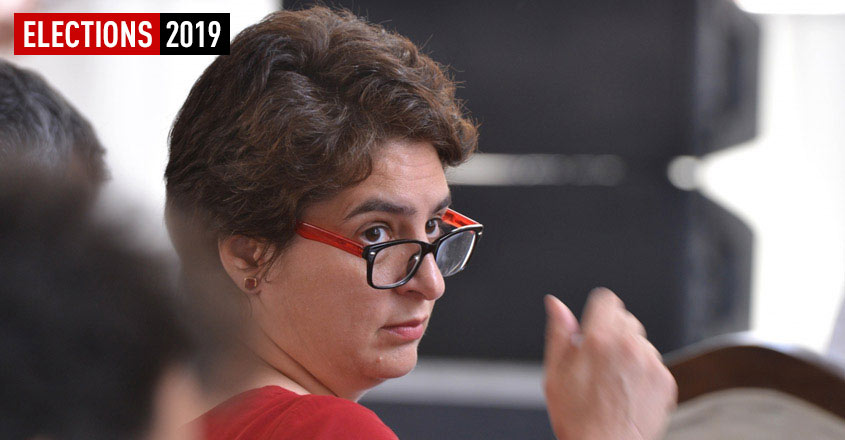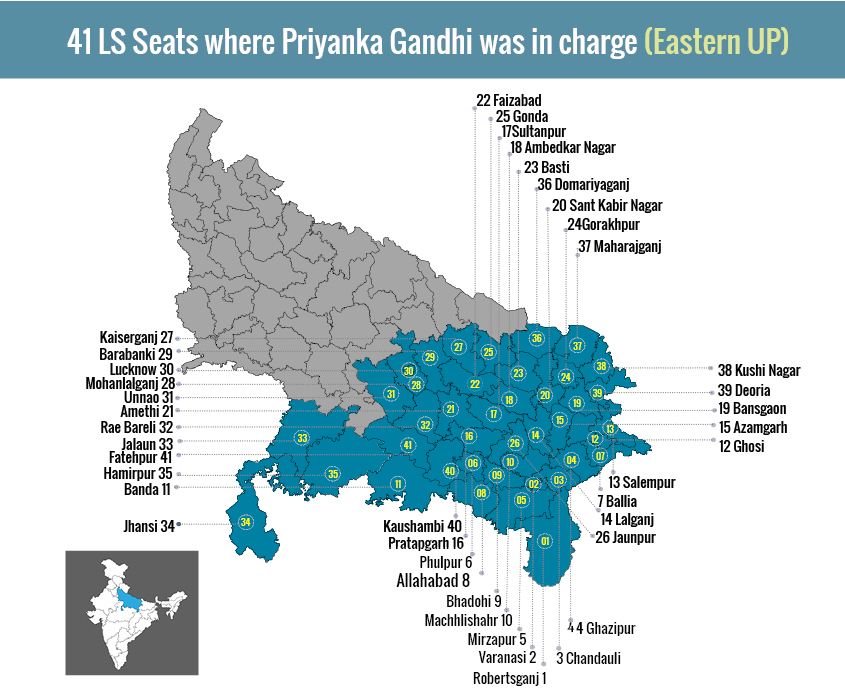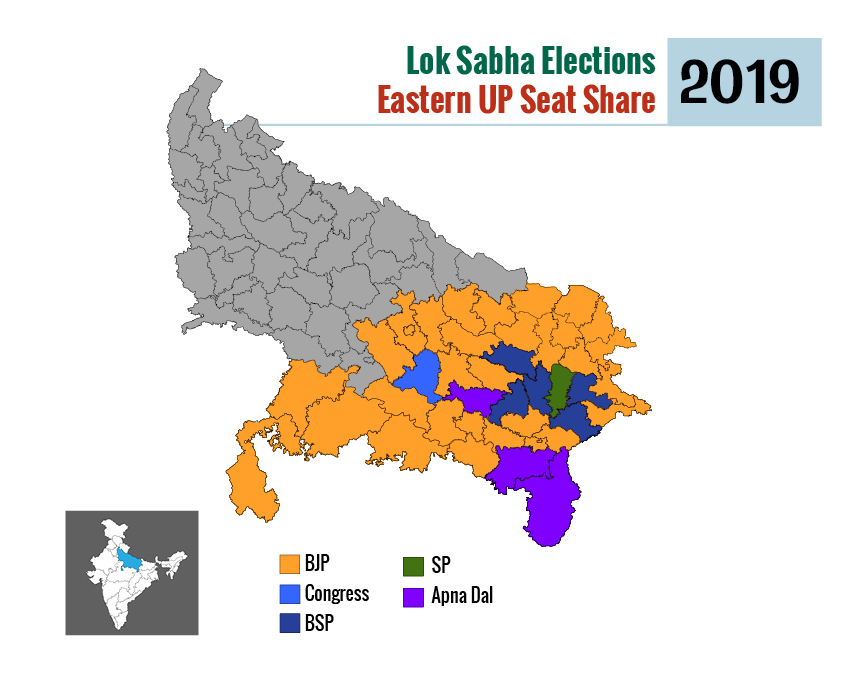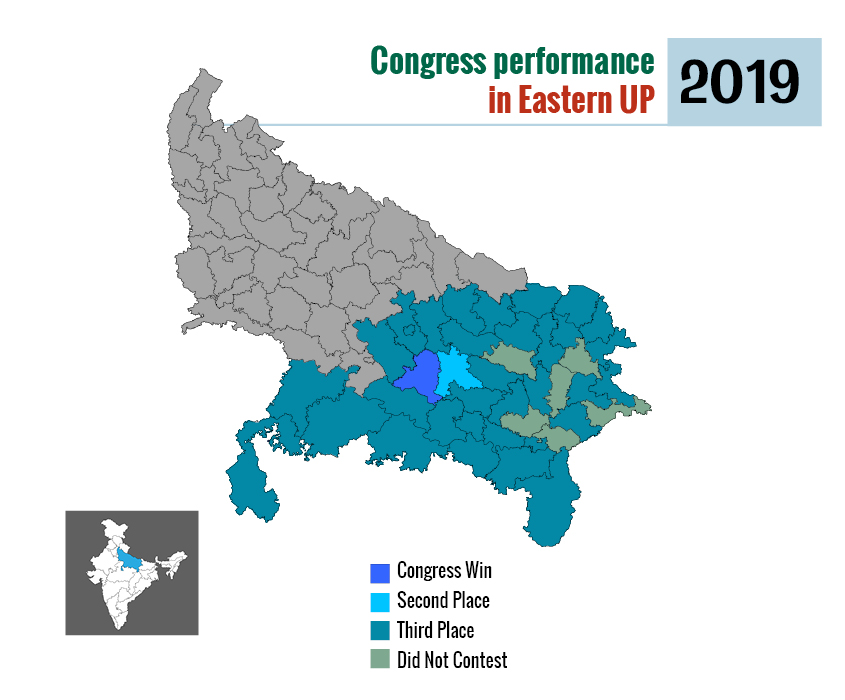
Confidence is the one characteristic that Priyanka exuded all through the campaign trail for the Lok Sabha elections 2019. Though the Priyanka magic dissipated, the down-to-earth dispensation and feet-on-the-ground approach won many hearts.
During her campaign in Rae Bareli, she had no qualms walking up to a snake-charmer who had a hood-flashed cobra by his side. As all the others coaxed him hard to put the reptile back inside the box, an unflappable Priyanka walked up to him and helped him do exactly that.
At another place, she alighted from the car, shook hands and wished the best to a couple of people who were raising pro-Modi slogans on the wayside.
On hindsight, the Priyanka Gandhi factor did not make an impact as the Congress thought it would – the BJP secured 61 of 80 seats in UP alone. Congress lost one of its precious two seats, that too her sibling Rahul Gandhi’s Amethi. In Eastern UP, where the Congress put Priyanka in charge as general secretary, the party contested in only 35 of the 41 seats. They lost in all 34, winning just one seat. It came second in Amethi and third in all the other places.
The initiation
Priyanka first campaigned for the Congress 20 years ago in 1999 for her mother, Sonia Gandhi, in Amethi. The party then fielded Rahul from Amethi and moved Sonia to Rae Bareli. Priyanka travelled the length and breadth of the constituencies with a spell of a smile and her subtle oratory. She was recently elevated as general secretary in charge of eastern UP; the party banking heavily on her to make a difference. The scene was grim when she was elevated – the party’s vote share was at an all-time low of seven per cent in 2014. This was a dip from the 51 per cent in 1984. The party machinery was loose and disorganized, if not in disarray. Priyanka had just 100 days to wave her magic wand and set things right.
Knowing BJP’s tactics
Eastern UP comprises the regions of Awadh and Purvanchal. The population of Awadh mainly consists of the upper castes. At least 13 per cent of the population of Awadh is Brahmins. The population traditionally supported the Congress but they cut the association a few years ago. The Congress thought there were two reasons why the upper castes would support them – the dismay of the Brahmins over Yogi Adityanath, a Rajput, being made the Chief Minister; and the 10 per cent reservation move of the BJP for the economically weaker among the forward castes.
The Congress vote share had been going up since 2007 in UP. Brahmins, Kurmis, and the Jats helped the Congress gain 21 seats in the 2009 Lok Sabha polls. But in 2014, the Kurmis and the upper castes voted for the BJPs and the Muslims for the Samajwadi Party (SP). But even then, the support of the upper castes, except Takurs and Brahmins, stayed with the Congress. This time around they too seemed to have abandoned the Congress.
The strategy
The Congress tried to project its own brand of Hindutva in UP through Priyanka. It wanted to capture the Hindu vote bank which it lost five years ago. But Priyanka did not want to loose sight of the other sections too – evident in her decision to start the campaign from Gangotri. The journey which started on march 18 was through regions with substantial Dalit and OBC presence, like Bhadohi and Mirzapur.
The party pinned much hopes on places like Khushinagar, Maharajganj, and Dumariaganj. But the party secured just 25,604 votes in Bhadohi and 91,392 in Mirzapur.
Women and youth
As per statistics, the BJP’s support base is in tact among those in the 18-22 age group. A study by the Centre for Study of Developing Societies (CSDS) indicated that the party had secured 51 per cent of the young population voted for the BJP. UP also has among the highest number of women voters. The Congress wanted to wield its influence on the youths and women too by fielding Priyanka.
Electoral stats
In 2014, UP had 13.88 crore voters. This time, the number rose to 14.43 crore, which meant 55 lakh new voters. This chunk of new votes went to the BJP, if election stats are to be believed. In eastern UP, the BJP secured most seats with a huge margin – an assertion of the new-voter support theory.
The CSDS report says the male voters form a major chunk of the Congress vote bank – approximately 59 per cent. The corresponding figure for BJP is 52 per cent. But women form a big chunk of the SP-BSP electorate, 53 per cent. Priyanka could wean away a chunk of women votes but that erosion happened from the SP-BSP combine, leaving the BJP unharmed.
In 2014, the BJP won in 36 places. An interesting fact is that in over 20 places, the SP and BSP votes put together was higher than the votes polled for the BJP. This paved way for Akhilesh and Mayawati to come together. But the SP-BSP combine was in for a rude shock when the Congress backed off from the alliance.
Over 40 per cent of UP’s population comprises backward classes. The SP intended to capture Dalit votes (22 per cent of the population) and Yadav votes (9 per cent). Also, the party eyed a share of the Muslim votes (19 per cent). The party was apprehensive that Priyanka would tear away a portion of the Muslim votes. SP’s Rampur MLA Azam Khan had reportedly requested Priyanka to desist from ‘splitting the Muslim vote bank of the SP.’ The Muslim population supports the SP but the electorate has no special affinity to the BSP. This is because the BSP leadership has no Muslim representation. Matters turned worse when Nasimuddin Siddiqui, former general secretary of BSP, joined the Congress immediately after the 2017 Assembly polls.
At least 50 office-bearers of the BSP joined the Congress in the past year and half.
BSP’s focus
The BJP mostly focussed on the 12 per cent Jatav vote share. Reports indicated that only 12 per cent of forward classes would vote for the SP-BSP combine. But the SP-BSP alliance expected to grab 60 per cent of SC-ST votes, 40 per cent of OBC votes, and 80 per cent of Muslim votes. The alliance expected support from Priyanka in this context. The BSP was of the thought that the votes of Dalits except Jatavs and backward classes except Yadavs from BJP bank would go to the Congress. The SP-BSP alliance thought the Priyanka factor would help weaken the BJP this way. The Congress but had another strategy in mind. It was sure to dent the prospects of the SP-BSP combine. But the results turned a nought, against all calculations.
No strongmen
In 2009 and 2014, the BJP banked heavily on the Brahmins and Thakurs among the upper classes. They were able to woo, among the lower classes, those except the Yadavs and Jatavs. The BJP thought Priyanka would dent this vote bank. But the Modi-Shah combine had their trump card in announcing a 10 per cent reservation in jobs for the economically backward among the upper castes.
The Congress found it tough to field candidates who could even give the BJP a tough fight. A case in point is the Brahmin-dominated Unnao. In 2014 and now, the BJP fielded Sakshi Maharaj. The BJP candidate secured 5.18 lakh votes in 2014. The SP and BSP candidates polled two lakh votes each and the Congress, 1.97 lakh. The Congress could not find and field anyone other than Anu tendon who came fourth in 2014.
The Congress also faltered on its plan to field the candidate of the same community as done by the BJP in every constituency.
Rahul Gandhi had himself stated that the party expected no major turnaround with Priyanka’s entry. The aim, sources said, was to capture the mandate in UP by 2022. The Congress placed its bet on Priyanka’s capability to connect with the masses and the reciprocal activity of its ranks on the ground. But now, with a diminished vote share and highly volatile ground support, it needs to be seen as to how her strategies for the 2022 Assembly polls would work.
(Graphics by Jain David M)





